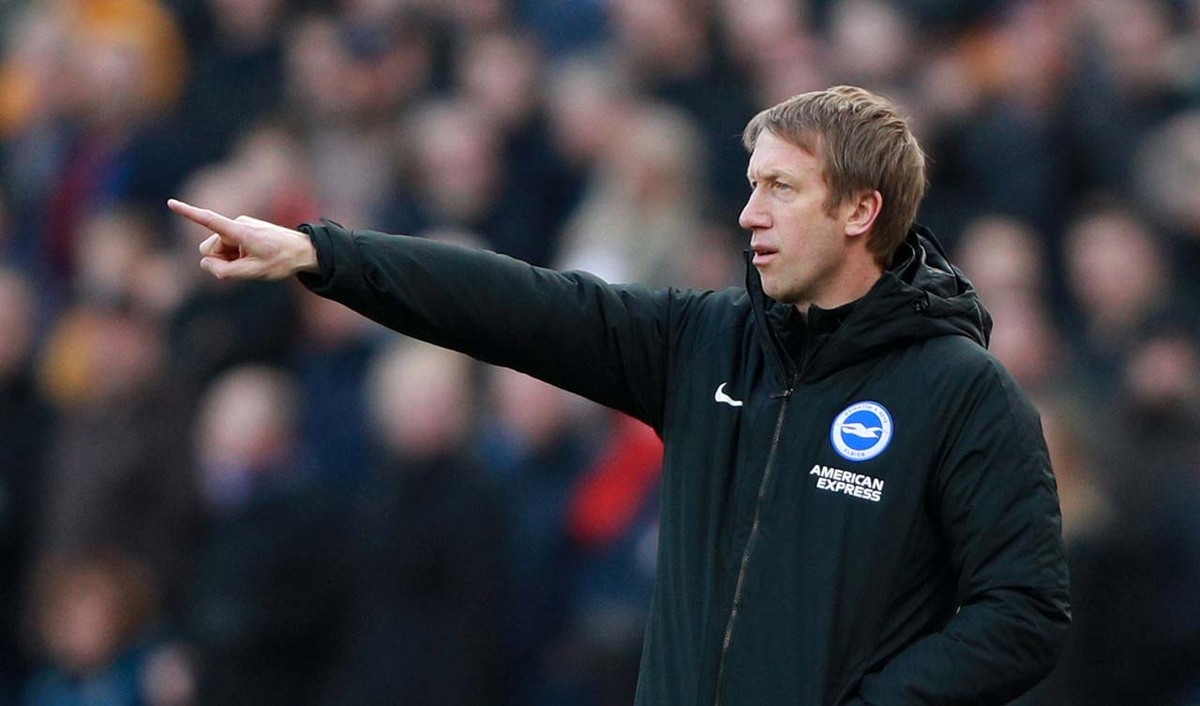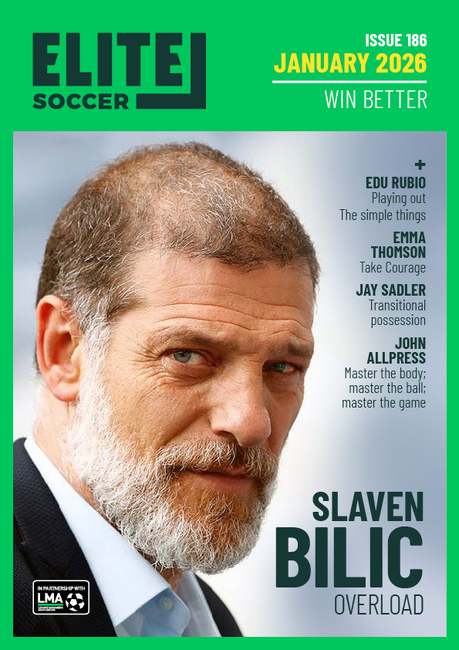




OUR BEST EVER OFFER - SAVE £100/$100
JOIN THE WORLD'S LEADING PROFESSIONAL DEVELOPMENT PROGRAMME
- 12 months membership of Elite Soccer
- Print copy of Elite Player & Coach Development
- Print copy of The Training Ground
You are viewing 1 of your 1 free articles
Defending in a mid block
This session is all about defending in a mid block and making a team hard to play through. It will teach players to work as a block and it will help them to understand exactly when to start pressing and what triggers to look for.
| Area | Up to two thirds of pitch |
| Equipment | Balls, bibs, cones, 2 goals |
| No. of Players | 15 players + 2 goalkeepers |
| Session Time |
Mid-block game: 15mins, Breaking lines: 12mins |
This session is all about defending in a mid block and making a team hard to play through. It will teach players to work as a block and it will help them to understand exactly when to start pressing and what triggers to look for.
It’s an important session and good communication is vital. It also helps teams to work on their aggressiveness inside the mid block.
We would run this session as a reminder once every four to five weeks.
What do I get the players to do?
Mid-block game
The players would start with a 15-minute warm-up with the fitness coach [not shown]. Then we set up on a 70-yard long area between the two penalty boxes and use the full width of the pitch. We have a goal and a goalkeeper at each end. The playing area is divided into four quarters with the final quarter tapered at each end, as shown. We’re using 15 players and two goalkeepers, divided into a red attacking team of nine including a keeper and a blue defending team of eight including a keeper. We are coaching the blue defending team.
The attacking team starts with the ball and plays out from the back with a pass from their keeper into the defensive zone. As soon as the ball goes into the pressing zone, the defending team presses aggressively and tries to win the ball or force a mistake, or maybe force the attackers to play back towards their own goal, as shown [1a].
1a
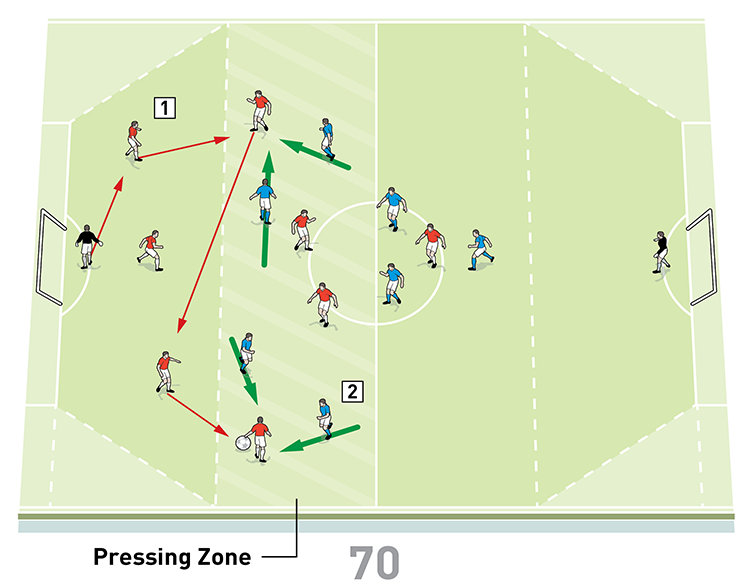
2. As soon as the ball goes into the pressing zone, the blue defending team presses to win the ball or force a mistake
If the mid press fails, then the red attacking team continues to attack and should try to score a goal, as shown [1b]. But if the blue defending team wins the ball, they should counter-attack and try to score, as shown [1c].
1b
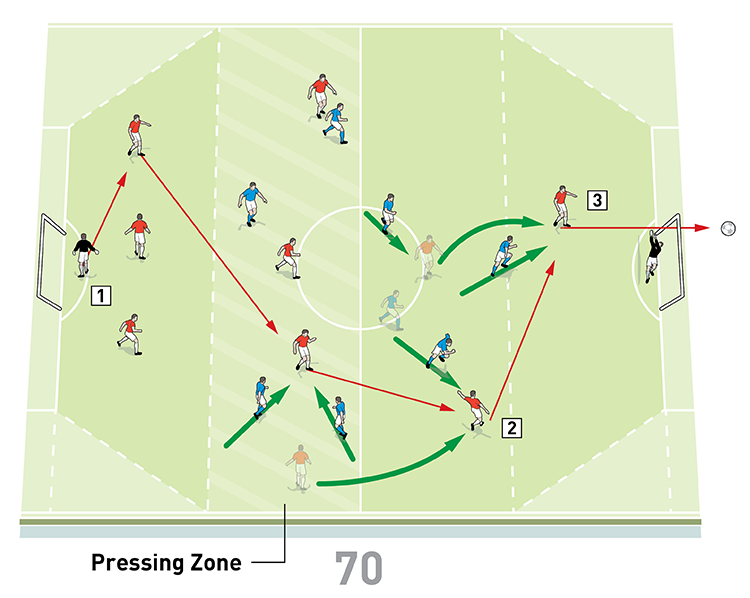
2. If the mid press fails and the blues are unable to win the ball in the pressing zone, the reds should continue to attack
3. Here the reds create a scoring opportunity
1c

2. If the blues win the ball they should counter-attack and try to score
The line into the final quarter serves as the offside line at both ends. We play four games of three minutes each.
What are the key things to look out for?
The key things that we have to look for is the distances between the defending players. We want to see players keeping compact and demonstrating that they are ready to press as soon as the ball crosses into the pressing zone. We also want to see players working together as a unit and communicating with each other.
What are the typical mistakes players might make and how do I avoid them?
One of the typical mistakes is that players fail to read the trigger points to press. Frustration is another factor as well, because sometimes they are not patient enough.
What do I get the players to do next?
Breaking lines
We set up an area of 45x44 yards divided into three 15-yard zones. We’re using 15 outfield players, split into three teams of five. One team is positioned in each zone. The teams at each end must try to pass the ball through the central block to the team at the opposite end, as shown [2a]. The team in the centre should try to stay compact and shift across as the ball is moved, making it hard to pass through them, as shown [2b]. The ball must stay below head height.
2a
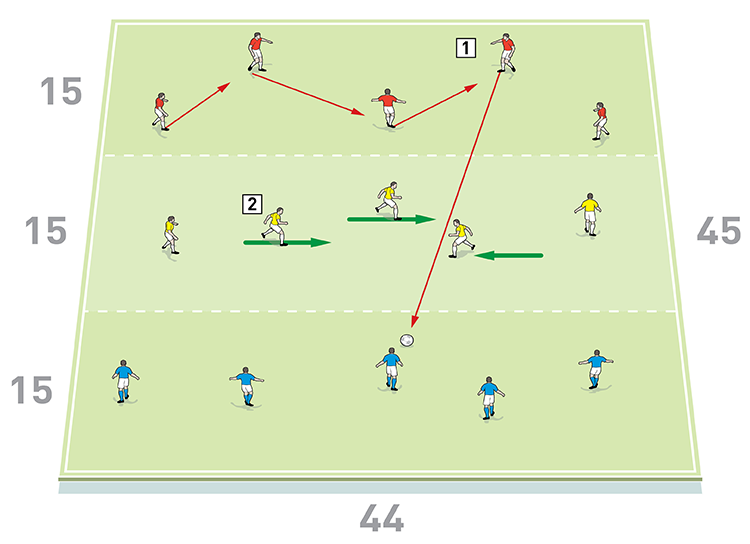
2. The central team must stay compact and make it hard to play through them
2b
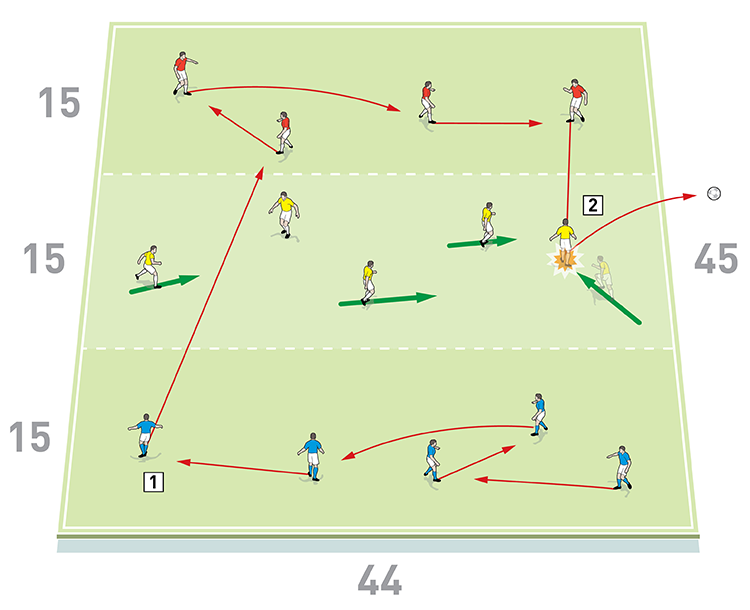
2. The team in the centre should stay compact and shift across. Here they succeed in forcing an error and clear the ball out of play
We play for 12 minutes, switching the teams over every two minutes so every group of players gets two turns as the defending team.
Related Files
Editor's Picks
Attacking transitions
Deep runs in the final third
Using the goalkeeper in build-up play
Intensive boxes drill with goals
Penetrating the final third
Creating and finishing
My philosophy
Pressing initiation
Compact team movement
Coaches' Testimonials

Alan Pardew

Arsène Wenger

Brendan Rodgers

Carlos Carvalhal

José Mourinho

Jürgen Klopp

Pep Guardiola

Roy Hodgson

Sir Alex Ferguson

Steven Gerrard
Related
Pre-season fitness plan
Play around to play through
Free-kick routines
Coaches' Testimonials

Gerald Kearney, Downtown Las Vegas Soccer Club

Paul Butler, Florida, USA

Rick Shields, Springboro, USA

Tony Green, Pierrefonds Titans, Quebec, Canada
Join the world's leading coaches and managers and discover for yourself one of the best kept secrets in coaching. No other training tool on the planet is written or read by the calibre of names you’ll find in Elite Soccer.
In a recent survey 92% of subscribers said Elite Soccer makes them more confident, 89% said it makes them a more effective coach and 91% said it makes them more inspired.
Get Monthly Inspiration
All the latest techniques and approaches
Since 2010 Elite Soccer has given subscribers exclusive insight into the training ground practices of the world’s best coaches. Published in partnership with the League Managers Association we have unparalleled access to the leading lights in the English leagues, as well as a host of international managers.
Elite Soccer exclusively features sessions written by the coaches themselves. There are no observed sessions and no sessions “in the style of”, just first-hand advice delivered direct to you from the coach.
